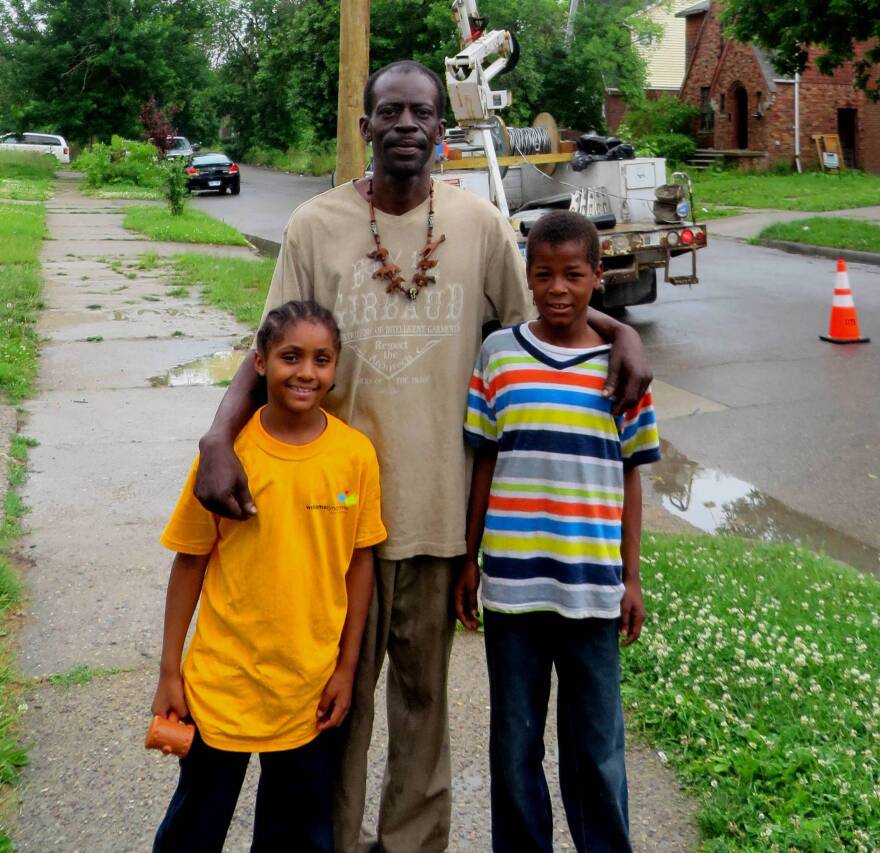This week the Detroit Journalism Cooperative is looking at how the city of Detroit is functioning under bankruptcy. Until recently, almost half the streetlights of Detroit were dark. Thousands of new streetlights are replacing the old broken ones.
I caught up with one of several crews installing streetlights in neighborhoods around Detroit. James England is the foreman.

“Ten to twelve lights a day is actually what we’re doing. We’ve got to run new wire to the backyard, to the easement, climb up the pole and run the wire back out here to the new pole and everything and then put up a new light mast. And everybody’s loving it. They’re just coming out and saying how they like the new lights and how they’re brighter. So, everything is going real well,” England said.
Altogether the crews are exceeding the 500 installations a week Mayor Duggan wants. More than 9,000 new lights are up.
This particular streetlight is going up in front of Cedrick Bell’s house and like most Detroiters, he’s pretty happy about it.
“It’s a crime deterrent. We have a nice little community right here in our own block. It’s a basic service that we really need and desire. And they’ve been very professional and quick about their job, I must say,” Bell said, standing in his front yard.
It’s been raining and the lineman in the bucket truck gets surprised by a spark from the live wire he’s hooking up to the light. Dave Martin says they do run into problems occasionally.
“Dealing with the dogs and the garbage. You know, that’s probably the worst part of the job. But, people have been nice to us, so it makes up for it.”
I asked Martin if the sparks are fun, too.
“And the sparks. I had to spark one right in front of you,” Martin said, laughing.
Crews say neighbors were so happy to see lights this past winter, they’d bring the crews coffee or hot chocolate, or offer to help however they could.
Crews started putting up lights in February once the Public Lighting Authority was established. It’s independent of the city although the mayor and the city council appoint its board members.

Odis Jones is the CEO of the Authority. He says since the new lights are brighter LEDs, they won’t need to install as many for the same coverage.
“You had 88,000 lights before, but only 50% of them were working. So, now you’re going to have 65,000 lights in the city that are working, that’s being maintained in the appropriate way,” Jones said.
The old high-pressure sodium lights and mercury vapor lights were wired up in a way that if one light went down a whole line of them did, kind of like old Christmas tree lights. And a lot of them went down because scrappers would steal the valuable copper. These new lights are wired with cheaper aluminum wire. The new lights will also last four to five times longer than the old lights, needing to be replaced every 15 to 20 years.
The electric costs for these LED streetlights is 60 to 70% less because they use a lot less power. There’s another plus. Those 88,000 street lights? The city had to pay a set fee for them whether they were lit or not. That cost $28 million a year.
So Jones says fewer, less expensive lights to power and maintain means a big drop in cost.

“We’re estimating the electric cost for the city is going to go down to approximately $5 million.”
Jones says shifting the responsibility from the bankrupt city to this new lighting authority is the only way the city could make the shift to lights that not only work, but also save power.
“You know, it is just so much more energy efficient to go LEDs. And we’re leading the country in doing that,” Jones explained.
If the Public Lighting Authority of Detroit stays on track, all the neighborhoods will be lit by the end of next year. All the thoroughfares will have the new streetlights by the end of 2016.
The authority also just got its credit rating upgraded to A-minus by Standard and Poors. That means it will be able to issue bonds to pay for the lights. That debt will be paid back by the utility tax Detroit residents pay.
For people such as Leslie Carse, whom I spoke to at a beauty parlor, those new lights make a difference.
“A lot of difference. You can actually see now when it gets dark out. It’s so much better.”
LG: Does it make you feel safer?
“Yes, it does.”
Support for the Detroit Journalism Cooperative on Michigan Radio comes from the John S. and James L. Knight Foundation, Renaissance Journalism's Michigan Reporting Initiative, and the Ford Foundation.




